The Return of the Pink Panther Blu-ray Movie
HomeThe Return of the Pink Panther Blu-ray Movie 
Shout Factory | 1975 | 113 min | Rated G | Jun 27, 2017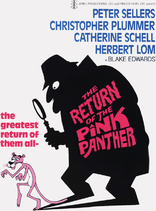
Price
Movie rating
7.2 | / 10 |
Blu-ray rating
| Users | 0.0 | |
| Reviewer | 3.5 | |
| Overall | 3.5 |
Overview
The Return of the Pink Panther (1975)
This time the bumbling French detective Inspector Clouseau is reluctantly called back into service by Chief Inspector Dreyfus when someone swipes the infamous Pink Panther diamond from the museum in Lugash. The prime suspect is the smoothly aristocratic jewel thief Sir Charles Lytton, aka the Phantom.
Starring: Peter Sellers, Christopher Plummer, Catherine Schell, Herbert Lom, Peter ArneDirector: Blake Edwards
| Comedy | Uncertain |
| Crime | Uncertain |
| Family | Uncertain |
| Mystery | Uncertain |
Specifications
Video
Video codec: MPEG-4 AVC
Video resolution: 1080p
Aspect ratio: 2.35:1
Original aspect ratio: 2.39:1
Audio
English: DTS-HD Master Audio 2.0 (48kHz, 24-bit)
1576 kbps
Subtitles
English SDH
Discs
Blu-ray Disc
Single disc (1 BD)
Playback
Region A (locked)
Review
Rating summary
| Movie | 4.0 | |
| Video | 3.5 | |
| Audio | 3.0 | |
| Extras | 3.5 | |
| Overall | 3.5 |
The Return of the Pink Panther Blu-ray Movie Review
Reviewed by Dr. Stephen Larson July 6, 2017The Return of the Pink Panther is being released as part of The Pink Panther Film Collection.
Exempting Inspector Clouseau (1968), which wasn't directed by Blake Edwards and didn't star Peter Sellers, The Pink Panther series went on an eleven-year hiatus without a film since A Shot in the Dark (1964) for reasons that are still not entirely clear. An idea for another sequel had been percolating in Edwards's mind for a long time and with The Return of the Pink Panther, that idea went from possibility to probability to finally eventuality. Edwards and Sellers had not had a big hit in a long while and their hopes pinned on this 1975 feature, which although distributed by United Artists, was financed independently. Edwards and co-scenarist Frank Waldman took a "back to the basics" approach with returning to the premise of Inspector Clouseau sleuthing for the priceless diamond that has supposedly been looted by the same Black Phantom that he chased in the series' first installment. Edwards and his cast/crew infuse The Return of the Pink Panther with new locations and find fresh ways to handle the comedic material and visual gags. I am in total agreement with Jason Simos on this BD's audio commentary that The Black Phantom's snatching of the Pink Panther jewel is one of the most brilliantly conceived heist sequences in all of cinema. Cinematographer Geoffrey Unsworth films a cat-burglar sliding along a cable from a nearby apartment-block after she or he has fired a crossbow. The black-clad figure sidles atop the roof of a minaret and archway belonging to the Middle Eastern Lugash Museum. The Phantom then slides down the cable and lands very stealthily on the entrance ground. Upon entering the Room of Jewels, The Phantom tries somehow to avoid the electronic eyes and radar shield by gingerly moving across the floor on its back. Once it reaches the pedestal of the Pink Panther diamond, The Phantom lowers one mechanical claw-device onto the jewel's cushion and tries to extract the gem with the other. The suspenseful sequence is perfectly shot and flawlessly executed by the stunt person in the suit.
General Wadafi (Peter Jeffrey) calls Clouseau (Peter Sellers) about the theft. After being reinstated following a suspension by his superior, Chief Inspector Charles Dreyfus (Herbert Lom), Clouseau flies into Lugash from France to meet with government officials. Clouseau quickly suspects that Sir Charles Litton (Christopher Plummer) is up to his old tricks again. Litton is relaxing in his swimming pool in Nice when his wife, Lady Claudine Litton (Catherine Schell), confronts him about a newspaper story reporting the burglary. Although he predicts that authorities will seek him, Charles tries to assure her that he wasn't the thief and pledges to remain in retirement.
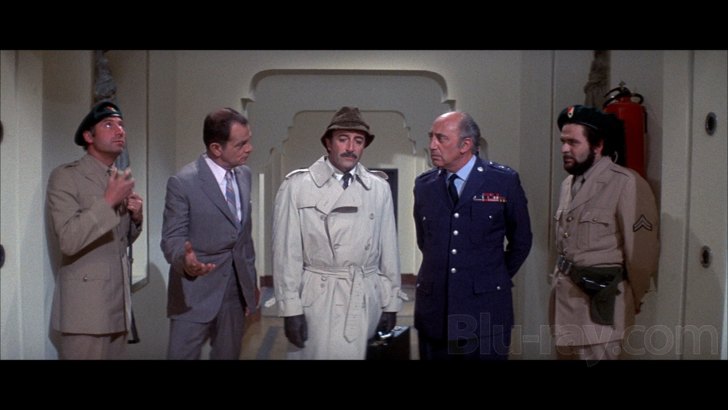
Inspector Clouseau begins another investigation of the precious stolen jewel.
Amid all the zany escapades involving Clouseau, who sports a French accent in the film, The Return of the Pink Panther becomes a picturesque travelogue featuring shooting locations in Marrakech, Casablanca, Nice, Gstaad (Switzerland), and London. After a lengthy and amusing sequence in which Clouseau infiltrates the Litton mansion as a telephone repairman, a contrived phone conversation lures him to a resort in Switzerland. Meanwhile, Charles has traveled to Lugash where he hopes to track down the pink panther. Sellers performs his gags in concert with Edwards's skillful direction. One leads to another such as when Clouseau monkeys with the Litton doorbell and later becoming entangled with a vacuum cleaner's jet thrust. As Charles Champlin of the Los Angeles Times observes in his review, "[Sellers] works well and comfortably with Edwards because the extravagant clown within Sellers feels right at home within Edwards' extravagant inventions." The supporting cast is equally up to the task. Plummer is a bit meaner in the role of Charles Litton than his predecessor, the ultra-suave David Niven. The Budapest-born blonde beauty Catherine Schell is alternately charming and treacherous. Herbert Lom's Dreyfus becomes increasingly obsessed with assassinating Clouseau. In all, the movie was a successful comeback of all sorts for both Edwards and Sellers.
The Return of the Pink Panther Blu-ray Movie, Video Quality 
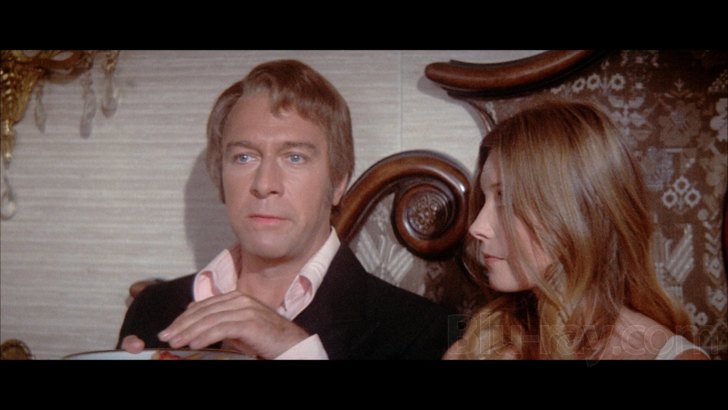
Shout Select presents The Return of the Pink Panther in its original theatrical aspect ratio of 2.35:1 on this MPEG-4 AVC-encoded BD-50, with a standard bitrate averaging 29999 kbps and total bitrate on the disc amassing 35.19 Mbps. Before examining the transfer and its UK counterpart, the reader should keep in mind the camera equipment, lighting conditions, et al. that were employed on the film. In an article for American Cinematographer (AC), production manager Peter Samuelson documents that the crew used the then-new Panavision Panaflex and also the HardFront wild Arris as backup, as well as for multi-camera use. Camera operator Peter Macdonald (future director of Rambo III) was saddled with the Studio Base for the Panaflex, which helped to provide coverage for very tight location interiors. According to Samuelson, the crew experienced exceedingly low-light levels during evening shoots in the alleyways and squares of Marrakech and Casablanca. For the carefully choreographed heist, director of photography Unsworth says in an AC interview that he used Panavision fast lenses and was aided by street lights below, as well as car headlights and traffic lights. Unsworth and his crew brought a significant number of quartz lights and Mini-Brutes (as Unsworth calls them) along so they could bounce off of ceilings and white walls. They also placed them behind brass columns and things where conventional lamps couldn't operate. While interior shots on the Shout transfer reveals a washed-out look (see various captures throughout), the glean and glistening look on the actors' faces is probably due to the presence of quartz lights that Unsworth spoke about. Another intent was to generate a soft effect when the camera panned within an interior. Camera crew only had one 1,000-amp generator, which means that only four arcs could be used. For exterior shots in Marrakech/North Africa, brute arcs were set up to fill the extremely bright sunlight (see Screenshot #13). Unsworth says he chose them because they're the only units that could match the bright sunlight.
The Shout transfer likely originates from the 2006 Universal DVD. In his critique of that disc, Peter Schorn of IGN notes that "the opening scenes are a swarm of grain, flicker and soft detail that made it appear that the print was stored in a sandbox. After that inauspicious beginning, it gets better without ever getting really good...Black levels and shadow detail are poor." Even though this isn't a new restoration, Shout seems to have cleaned some of these issues up. Shout's print also probably emanates from the source used by UK-based Fabulous Films for its Blu-ray. Based on what I've gathered about that transfer, Shout's appears to have less print damage, though. There are occasional blemishes, such as the two thin tramlines and scratch on the right side in #14. The animated titles designed by Richard Williams look clean in pink and cherry red (see #s 15-17). The transfer is still far from perfect but I believe there have been at least minor and subtle improvements made compared to the first BD release.
The Return of the Pink Panther Blu-ray Movie, Audio Quality 
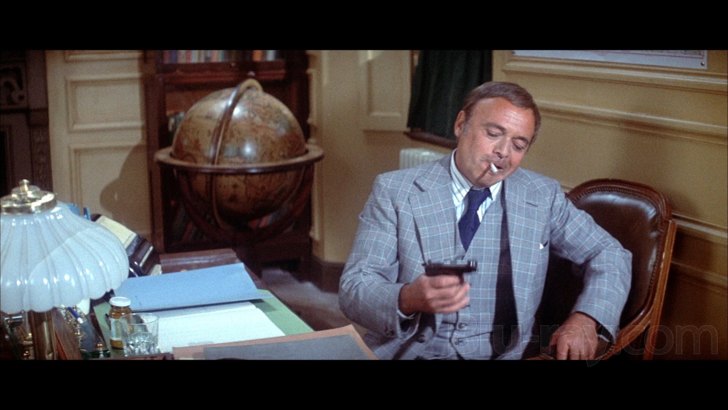
Shout has only included a DTS-HD Master Audio 2.0 Dual Mono (1576 kbps, 24-bit). Henry Mancini's main theme sounds warm and jazzy. Dialogue is mostly intelligible (especially once you get used to Sellers's accent). Though not wholly necessary, a stereo option or a 5.1 remix could have exploited the f/x more from the various sight gags. It also could have provided a boosted ambiance for the on-location scenes.
Shout has included optional English SDH for the main feature.
The Return of the Pink Panther Blu-ray Movie, Special Features and Extras 
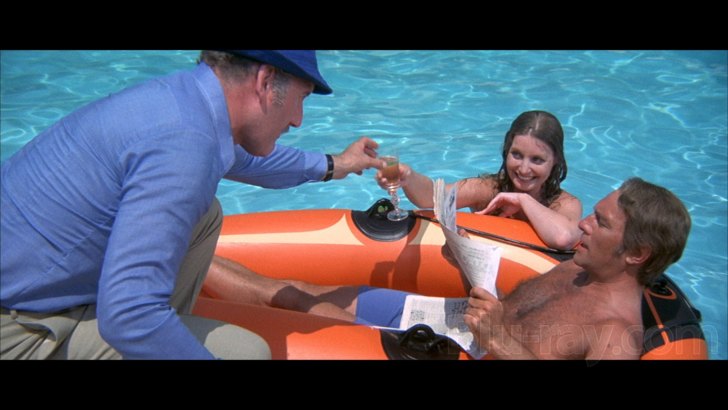
- NEW Audio Commentary by Jason Simos of The Peter Sellers Appreciation Society - an above-average commentary track by Simos with occasional small gaps. He delivers his interpretations of characters/scenes and broaches several of the filmed deleted scenes from the script that were dropped or reworked in subsequent films. Some additional trivia and production info would have made it better but it's a pretty solid talk. In English, not subtitled.
- NEW Featurette – A Bit of Passion and Lots of Laughs: An Interview with Actress Catherine Schell (21:49, 1080p) - The performer of Lady Litton gives recollections of Edwards, Sellers, and Plummer as well as advising viewers to check out the recent book on her acting career (A Constant Alien). In English, not subtitled.
- NEW Featurette: An Interview with Production Designer Peter Mullins (28:04, 1080p) - art/set decorator Mullins discusses his collaborations with Edwards and provides various details on their productions. He also provides tidbits on the aborted project, Romance of the Pink Panther, which was scripted by Sellers and Jim Moloney. In English, not subtitled.
- 1975 Featurette: The Return of Laughter (The Making of The Return of the Pink Panther) (8:22, upconverted to 1080) - a brief making-of-doc with footage on the set. A nice pickup from the vault by Shout. In English, not subtitled.
- Theatrical Trailers (6:10, upconverted to 1080) - several trailers for The Return of the Pink Panther presented in 2.35:1 anamorphic widescreen and re-release trailers for the series' other films. In English, not subtitled.
- TV Spots (3:26, upconverted to 1080) - a handful of unrestored TV spots about The Return of the Pink Panther that appear in fair to mediocre condition. One includes a few bloopers and outtakes. In English, not subtitled.
- Radio Spots (2:30) - four radio spots that aired to promote The Return of the Pink Panther. In English, not subtitled.
- Still Gallery (3:11, 1080p) - the first fifteen images presented in the slide show consist of high-res studio photos in color of Sellers and Herbert Lom. The next twenty-five contain black-and-white press kit shots of the main stars and the supporting players. A color photograph of Sellers in his police uniform concludes the presentation.
- Poster Gallery (2:18, 1080p) - thirty (mostly color) US/international theatrical release posters, ad slicks, vintage lobby cards, and other promo material.
- Rare Image Gallery (0:44, 1080p) - a cartoon sketch, production candids, and additional pictures from United Artists' ad campaign.
The Return of the Pink Panther Blu-ray Movie, Overall Score and Recommendation 
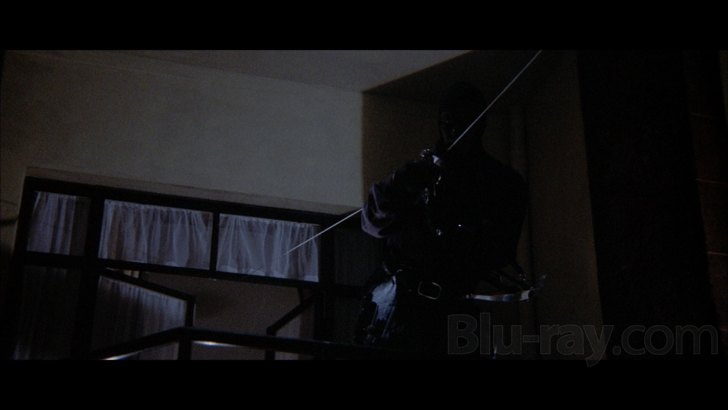
The Return of the Pink Panther mostly fires on all cylinders and ranks high on my list for best sequel in the series. Shout's transfer offers a slight upgrade over Fabulous Film's BD but greatly advances in way of a plethora of new bonus materials. The UK edition offered zilch while Shout recorded a solid commentary track, two new interviews, vintage featurettes, and photo galleries. HIGHLY RECOMMENDED.
Similar titles
Similar titles you might also like
(Still not reliable for this title)

Revenge of the Pink Panther
4K Restoration | Special Edition
1978

Trail of the Pink Panther
1982

The Pink Panther Strikes Again 4K
1976

A Shot in the Dark 4K
1964

Inspector Clouseau
1968

Who Done It?
1942

Pure Luck
1991

Who's Harry Crumb?
Retro VHS Collection
1989

Curse of the Pink Panther
1983

The Naked Gun: From the Files of Police Squad! 4K
1988

Show Dogs
2018

Mr. Popper's Penguins
2011

Furry Vengeance
2010

The War with Grandpa
2020

Going in Style
2017

The Pink Panther
2006

Police Squad!: The Complete Series
1982

Monk: The Complete First Season
2002

The Pink Panther 2
2009

Me, Myself & Irene
2000
